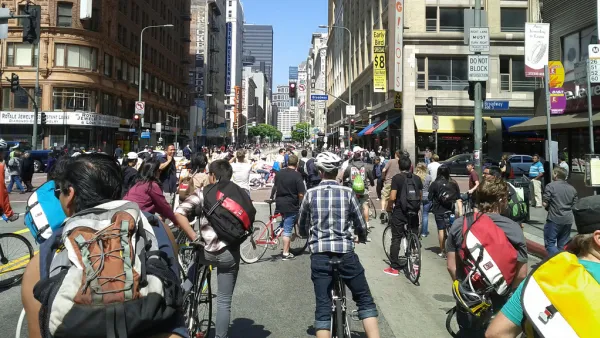Days before the American Planning Association's national convention, CicLAvia's Aaron Paley describes the event's origins and evolution and explains how an open streets event in Los Angeles can transform one's sense of public space and the city.
On Sunday, April 15th, LA neighborhoods from East Hollywood to Boyle Heights will transform, as major boulevards become car-free pedestrian and bike spaces during CicLAvia. The Planning Report sat down with Aaron Paley, president of Community Arts Resources (CARS) and a founder of the public event, to discuss the conceptual underpinnings of the CicLAvia, how it is organized, and where it is growing and evolving. Inspired by the weekly Ciclovia in Bogotá, the Los Angeles event is expected to attract over 100,000 participants, and planners hope to see it happen more often and in different neighborhoods across the large city.
Paley emphasizes that CicLAvia, in his mind, is not just about bicycles and exercise-it's a fun experience of public space that transforms one's concept of how we as individuals relate to the city. CicLAvia is an opportunity for residents to see, smell, and hear the streets of Los Angeles without its famous traffic. Paley notes, "For planners, really, the lesson that can be taken away here is that temporary interventions-light, quick, cheap, ways of transforming the city-can be just as influential as brick, mortar, and concrete. Through this method we can take more risks and show how things can get done in a demonstrative way."
Thanks to Kevin Madden
FULL STORY: CicLAvia's Aaron Paley on the Spectacle's Trajectory, Notions of Public Space

National Parks Layoffs Will Cause Communities to Lose Billions
Thousands of essential park workers were laid off this week, just before the busy spring break season.

Retro-silient?: America’s First “Eco-burb,” The Woodlands Turns 50
A master-planned community north of Houston offers lessons on green infrastructure and resilient design, but falls short of its founder’s lofty affordability and walkability goals.

Delivering for America Plan Will Downgrade Mail Service in at Least 49.5 Percent of Zip Codes
Republican and Democrat lawmakers criticize the plan for its disproportionate negative impact on rural communities.

Test News Post 1
This is a summary

Test News Headline 46
Test for the image on the front page.

Balancing Bombs and Butterflies: How the National Guard Protects a Rare Species
The National Guard at Fort Indiantown Gap uses GIS technology and land management strategies to balance military training with conservation efforts, ensuring the survival of the rare eastern regal fritillary butterfly.
Urban Design for Planners 1: Software Tools
This six-course series explores essential urban design concepts using open source software and equips planners with the tools they need to participate fully in the urban design process.
Planning for Universal Design
Learn the tools for implementing Universal Design in planning regulations.
EMC Planning Group, Inc.
Planetizen
Planetizen
Mpact (formerly Rail~Volution)
Great Falls Development Authority, Inc.
HUDs Office of Policy Development and Research
NYU Wagner Graduate School of Public Service




























